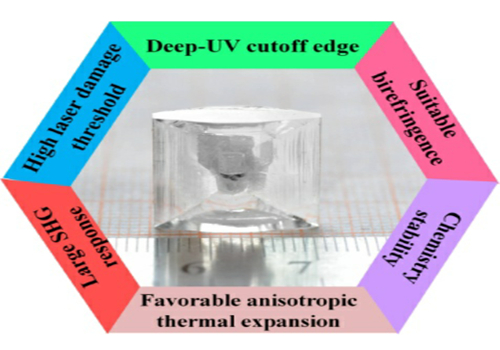Nonlinear optical (NLO) materials are the vital components of future photoelectric technologies as they can broaden the tunable wavelength range supplied by common laser sources. However, the necessary prerequisites for a practical NLO material are rather strict. Accordingly, considerable efforts have been focused on finding potential NLO materials.
Recently, a research group led by Prof. Pan Shilie at Xinjiang Technical Institute of Physics & Chemistry of Chinese Academy of Science have successfully designed and synthesized two new asymmetric beryllium-free borates Pna21- and P 2m-Ba3Mg3(BO3)3F3 featuring NLO-favorable layered structures through chemical cosubstitution strategy. The study was published in Nature Communications.
2m-Ba3Mg3(BO3)3F3 featuring NLO-favorable layered structures through chemical cosubstitution strategy. The study was published in Nature Communications.
Single crystals of two polymorphs were obtained and solved with the cooperation of Prof. Sun Junliang from Peking University. The relatively low temperature factors and residual factors verify the correctness of those two crystal models, which also indicates the existence of two polymorphs. Furthermore, the Ba3Mg3(BO3)3F3 polymorphs and phase transitions are further confirmed by high-temperature in situ powder X-ray diffraction and thermal expansion coefficients experiment. More importantly, large size single crystals of Pna21-Ba3Mg3(BO3)3F3 were grown through finding the suitable flux system. The optical measurements based on the crystal reveal that Pna21-BMBF possesses the NLO properties required for the ultraviolet NLO applications, including a sufficiently large SHG coefficient (d33 = 0.51 pm/V), suitable birefringence (0.045@532 nm), a large LDT (~ 6.2 GW/cm2), a deep-ultraviolet cutoff edge (λ ~ 184 nm), a weak anisotropic thermal expansion, the capacity of insolubility in water, type I phase-matchability, and chemical stability. Thus these merits on optical properties make Pna21-Ba3Mg3(BO3)3F3 a promising ultraviolet NLO material.
This work was financially supported by National Natural Science Foundation of China, National Key Research Project, and Xinjiang Key Research and Development Program.
https://www.nature.com/articles/s41467-018-05575-w

The basic physicochemical properties of Pna21-Ba3Mg3(BO3)3F3 crystal
